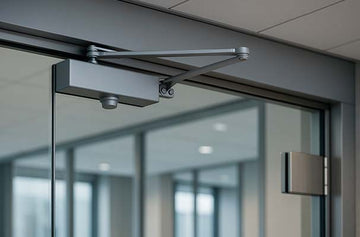
When it comes to architectural glass doors whether in commercial buildings or modern residential spaces, door closers play a critical role in ensuring smooth operation, safety, and long-term durability. A high-quality door closer ensures that a door closes automatically and securely, maintaining both functional performance and aesthetic value.
In frameless and minimalist environments, the type of door closer you choose can significantly impact not just usability, but the overall look and feel of the space. This guide explores the key types of door closers used in glass installations, their functions, advantages, and how to choose the right one for your project.
What is a Door Closer?
A door closer is a mechanical or hydraulic device that ensures a door returns to its closed position after being opened. It regulates the speed and force of the closing action, preventing slamming, reducing noise, and improving security.
In the context of frameless glass systems, door closers must also maintain the clean, uninterrupted lines of the glass panels, making discreet installation and compatibility essential.
Main Functions of a Door Closer:
- Controlled Closing: Prevents slamming and ensures a smooth return.
- Latching Action: Ensures the door closes completely and securely.
- Back-Check Protection: Prevents damage from forceful openings.
- Adjustability: Allows fine-tuning for door weight, air pressure, and usage frequency.
At Quality Glass Fittings, we offer a full range of hydraulic door closers, including options for overhead, floor-mounted, concealed, and patch fitting styles—each designed to meet the high standards required for glass and frameless installations.
Types of Door Closers for Glass Systems

1. Overhead Door Closers
Overhead closers are mounted on the door frame or header above the door. They are more visible than other options but offer robust support for heavy or frequently used doors.
Where They’re Used:
- High-traffic commercial doors
- Internal glass doors in offices or public spaces
- Entrances where aesthetics are less critical than durability
Advantages:
- Handles heavy doors and wide openings
- Easy to adjust or maintain
- Requires no floor or glass cutout
Considerations:
- Visually more prominent—may not suit minimalist spaces
- Requires secure header or frame mounting
2. Hydraulic Patch Fittings
Hydraulic patch fittings (or patch closers) are compact closers integrated into the top or bottom corner of the glass door. They offer clean, almost invisible installations—perfect for modern frameless glass entrances.
How They Work:
The hydraulic mechanism is housed in a small metal enclosure at the edge of the glass. These patches work in tandem with floor pivots or top hinges to control door movement.
Ideal For:
- Frameless glass entrance doors
- Office partitions and meeting room doors
- Retail storefronts
Advantages:
- Minimal visual impact
- Maintains the clean look of frameless glass
- Adjustable force and closing/latching speeds
Considerations:
- Requires precise glass cut-outs
- Needs to be paired with compatible pivots or hinges
- Typically higher cost than basic closers
Where to Find:
Browse our range of Hydraulic Patch Fittings—complete with size specs, glass compatibility, and installation drawings.
3. Floor Spring Door Closers
Installed beneath the floor or in a recessed box under the door, floor springs offer powerful and invisible door control. They’re ideal for maintaining a flush, seamless design.
How They Work:
The door is connected via a spindle to the concealed floor spring unit, which contains a hydraulic mechanism. This system supports single or double-action movement.
Best Suited For:
- Heavy frameless glass doors
- Lobby or main entrances
- Double-action doors (doors that swing both directions)
Advantages:
- Fully concealed for a clean look
- Supports large or heavy doors
- Built for durability in high-use areas
Considerations:
- Requires subfloor space and proper reinforcement
- Installation and servicing are more complex
- Must be planned in the early design phase
4. Concealed & Automatic Door Closers
These closers are hidden within the door frame, door edge, or ceiling header. They can also be motorized, offering automatic closing, motion sensing, or hold-open functionality.
Types Include:
- Frame-mounted concealed closers
- Door-edge mounted closers
- Electromagnetic or sensor-based closers
Perfect For:
- High-end residential interiors
- Glass doors in tech offices or showrooms
- Applications requiring full automation
Advantages:
- Fully hidden for maximum aesthetic value
- Can integrate with access control systems
- Smooth and silent operation
Considerations:
- Higher cost due to complexity
- Installation requires precise door and frame design
- Maintenance may require specialist knowledge
How to Choose the Right Door Closer

Selecting the best closer for your glass door involves considering both technical and visual factors. Here’s a quick checklist:
- Door Weight & Dimensions: Check the maximum supported door weight and size listed in product specs.
- Glass Thickness & Cutout Requirements: Ensure your glass is compatible with patch fittings or concealed closers. Cutout templates are usually provided.
- Single vs Double Action
- Single-action: Door swings one way (typical for private rooms)
- Double-action: Door swings both ways (common in public/commercial entrances)
- Hold-Open or Back-Check Functions
- Hold-open is ideal for doors that need to stay open temporarily
- Back-check is useful for windy conditions or high-traffic zones
- Installation Constraints
- Limited floor depth? Avoid floor springs.
- Thin header space? Consider patch or concealed closers.
- Maintenance Access: Think about how easy it is to access and service the closer over time.
- Design Preferences: For premium, minimalist spaces, go with hydraulic patch or concealed closers. Overhead closers are better for utility-focused areas.
Conclusion
Choosing the right door closer isn’t just about functionality—it’s also about preserving the design integrity of your glass system. Whether you opt for a heavy-duty overhead closer, an elegant hydraulic patch fitting, or a fully hidden floor spring, Quality Glass Fittings offers a solution engineered for durability, precision, and architectural compatibility.
Our product lines cover a wide range of glass door closers, each supported with technical drawings, compatibility charts, and expert advice. With the right selection, you ensure a safer, smoother, and more beautiful door experience—for years to come.

